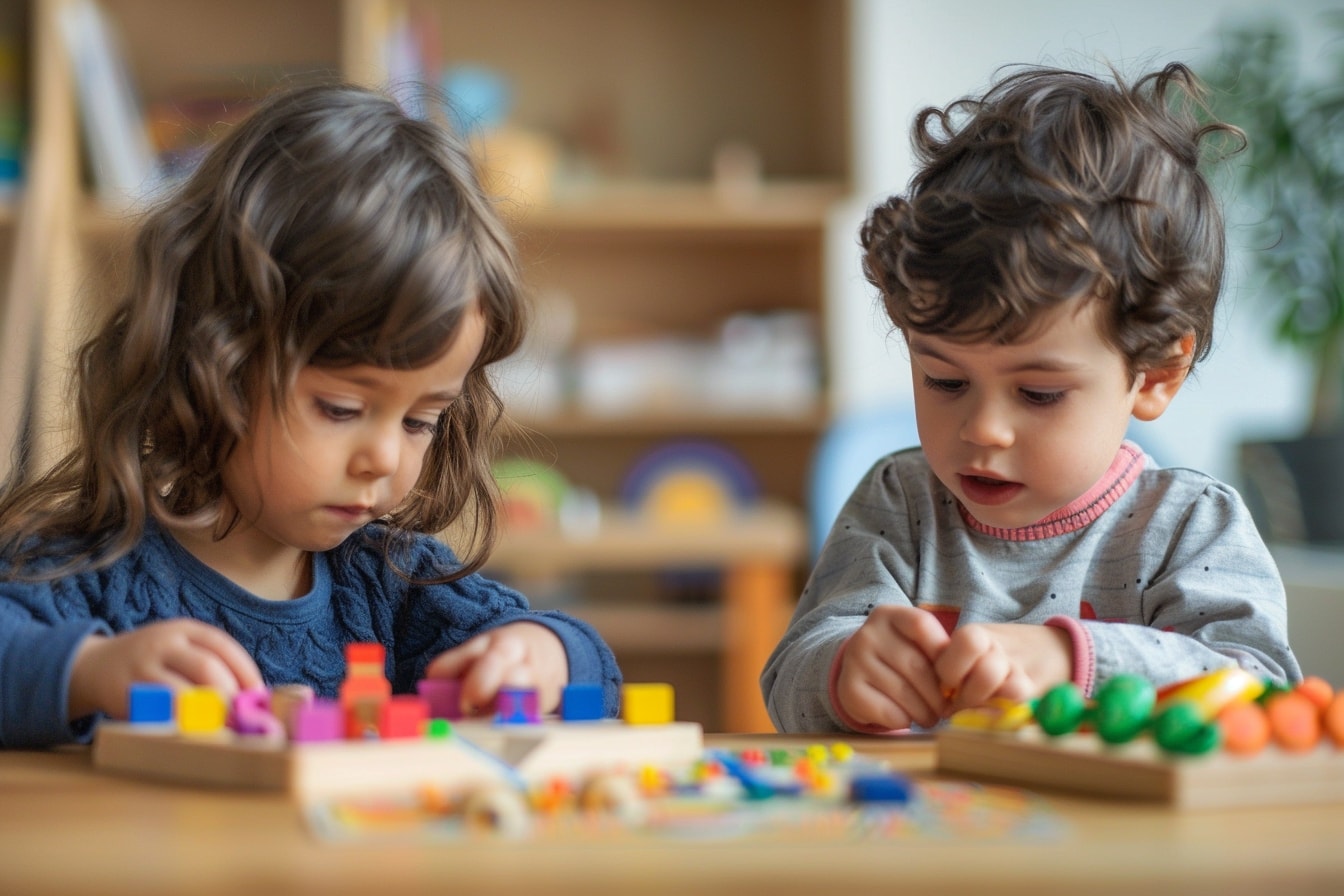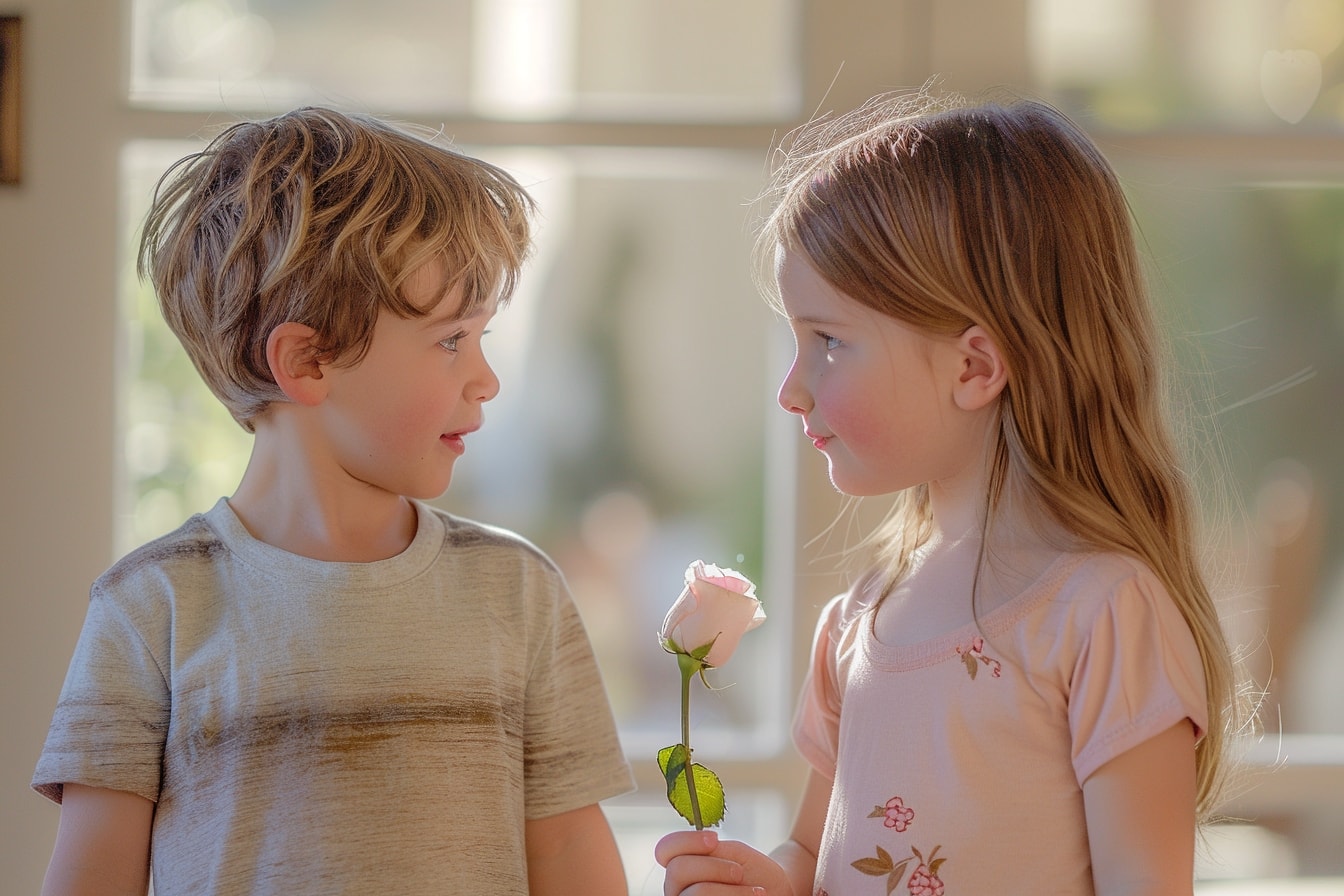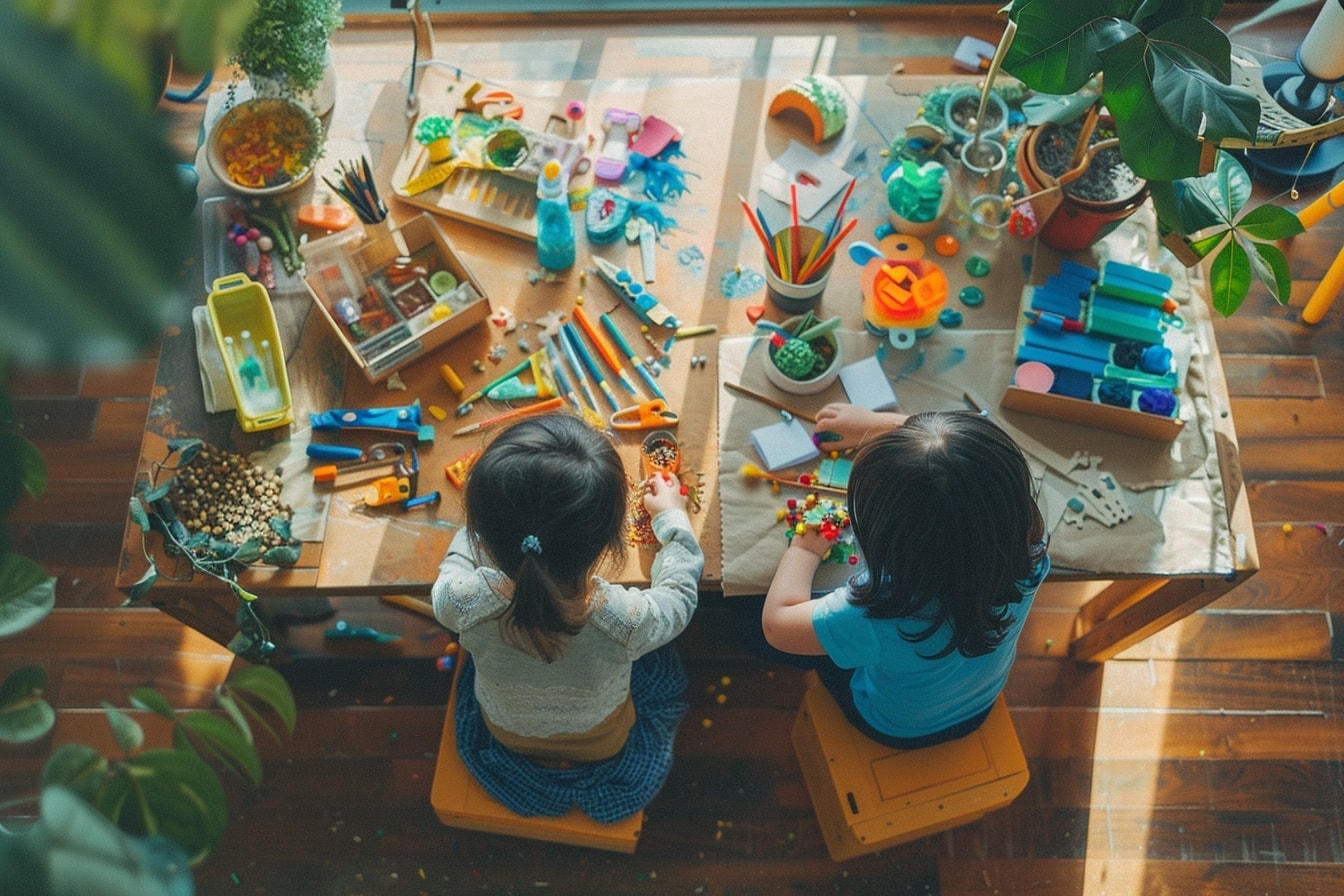Table of Contents
ToggleMontessori and Sibling Relationships: Fostering Harmony Early On
Picture this: It’s a typical afternoon in our household, filled with the laughter of children playing and the occasional sound of squabbles echoing through the halls. As a parent, navigating the intricate dance of sibling relationships is both a joy and a challenge. I’ve come to realize that these relationships are more than just the bonds between siblings; they’re the building blocks of our family dynamic, shaping the way our children learn, grow, and relate to one another and the world around them.
Research suggests that sibling relationships play a pivotal role in a child’s development, influencing everything from social skills to emotional resilience. Yet, fostering harmony among siblings is no easy feat. Rivalry, jealousy, and conflicting personalities can often cloud the peaceful coexistence we strive for as parents.
This is where the principles of Montessori education come into play. Rooted in the belief that children are inherently capable and deserving of respect, Montessori philosophy offers a unique perspective on nurturing positive sibling dynamics. By embracing concepts such as independence, cooperation, and empathy, we can create an environment where siblings not only coexist but thrive together.
In this article, we’ll explore how Montessori principles can be applied to sibling relationships, providing practical insights and strategies for fostering harmony early on. From promoting mutual respect and empathy to navigating conflict resolution and creating a collaborative environment, we’ll delve into the ways in which Montessori-inspired approaches can transform sibling dynamics and lay the foundation for lifelong bonds.
So, join me on this journey as we discover the power of Montessori in shaping sibling relationships and creating a home filled with love, understanding, and harmony.

Understanding Montessori Principles in Sibling Dynamics
When it comes to fostering harmony among siblings, the teachings of Maria Montessori offer invaluable insights into creating a nurturing and respectful environment. At the heart of Montessori philosophy lies the belief in the inherent capabilities of children and the importance of providing them with opportunities to learn and grow at their own pace.
One of the fundamental principles of Montessori education is the concept of independence. Montessori educators emphasize the importance of allowing children to take ownership of their learning and development, empowering them to explore their interests and abilities autonomously. This principle can be applied to sibling relationships by encouraging each child to express themselves freely and pursue their individual passions.
Another cornerstone of Montessori philosophy is respect. In a Montessori classroom, children are taught to respect themselves, their peers, and their environment. This principle translates seamlessly into sibling dynamics, where mutual respect forms the bedrock of positive relationships. By modeling respectful communication and conflict resolution techniques, parents can create an atmosphere of understanding and cooperation among siblings.
Cooperation is also central to Montessori education. Montessori classrooms are designed to promote collaboration among children, allowing them to work together on projects and solve problems as a team. Similarly, fostering a spirit of cooperation among siblings encourages them to support each other’s growth and celebrate each other’s successes.
Furthermore, Montessori philosophy emphasizes the importance of following the child. This means observing each child’s unique interests, abilities, and developmental stage, and tailoring learning experiences to meet their individual needs. Applying this principle to sibling relationships involves recognizing and honoring each child’s strengths and limitations, fostering a sense of acceptance and understanding between siblings.
By embracing these Montessori principles in sibling dynamics, parents can create an environment where children feel valued, respected, and empowered to develop meaningful connections with their siblings. Through independence, respect, cooperation, and individualized attention, we can lay the foundation for strong, positive sibling relationships that endure for a lifetime.

Promoting Mutual Respect and Empathy
At the core of fostering harmonious sibling relationships lies the essential values of mutual respect and empathy. As parents, it’s our responsibility to cultivate an environment where these values are not only taught but embodied in our daily interactions with our children.
Mutual respect forms the foundation of positive sibling dynamics. It involves recognizing and honoring each child’s unique perspective, feelings, and boundaries. By fostering an atmosphere of respect within the family, we can create a space where siblings feel safe expressing themselves openly and honestly.
- Modeling Respectful Communication: Children learn by example, so it’s essential for parents to model respectful communication in their interactions with each other and with their children. This means listening attentively, speaking kindly, and acknowledging each other’s viewpoints.
- Setting Clear Expectations: Establishing clear boundaries and expectations for behavior helps children understand what is acceptable and respectful in their interactions with siblings. By setting consistent limits and enforcing them with love and understanding, parents can create a framework for mutual respect to flourish.
- Encouraging Empathy: Empathy is the ability to understand and share another person’s feelings. By encouraging empathy in our children, we teach them to consider the perspectives and emotions of their siblings. This can be fostered through activities such as role-playing, storytelling, and discussing feelings openly as a family.
Empathy goes hand in hand with respect, as it involves recognizing and validating each other’s emotions. By teaching our children to empathize with their siblings, we instill in them the value of kindness, compassion, and understanding.
Moreover, promoting mutual respect and empathy among siblings fosters a sense of unity and cooperation within the family. When children feel respected and understood by their siblings, they are more likely to collaborate, compromise, and support each other’s growth.
Ultimately, by prioritizing mutual respect and empathy in sibling relationships, we lay the groundwork for strong, enduring bonds built on love, understanding, and shared experiences.

Navigating Conflict Resolution Through Montessori Techniques
Conflict is an inevitable part of sibling relationships, but how we navigate and resolve it can make all the difference in fostering harmony at home. Montessori philosophy offers valuable insights and techniques for helping children learn to manage conflicts peacefully and constructively.
One of the key principles of Montessori conflict resolution is empowering children to resolve disputes independently. Rather than swooping in to solve every conflict for them, parents can act as guides, providing support and guidance as children learn to navigate conflicts on their own.
- Teaching Active Listening: Encouraging children to listen attentively to each other’s perspectives is essential for resolving conflicts effectively. Montessori-inspired activities, such as using a talking stick or practicing reflective listening, can help children develop active listening skills and understand each other’s point of view.
- Encouraging Problem-Solving: Instead of focusing on assigning blame or finding a winner and a loser, Montessori conflict resolution emphasizes finding mutually beneficial solutions. Parents can encourage children to brainstorm creative solutions to their conflicts and work together to find compromises that satisfy everyone involved.
- Modeling Calmness and Patience: Children look to their parents as role models for how to handle conflicts. By staying calm and patient during disagreements, parents can demonstrate effective conflict resolution skills and teach children the importance of approaching conflicts with a calm and rational mindset.
Furthermore, Montessori philosophy emphasizes the importance of fostering empathy and understanding in conflict resolution. When children learn to consider each other’s feelings and perspectives, they are better equipped to find peaceful resolutions to their conflicts.
Montessori-inspired conflict resolution techniques not only help children resolve their immediate conflicts but also teach them valuable skills that they can carry with them into adulthood. By empowering children to navigate conflicts independently, we help them develop the resilience, empathy, and problem-solving abilities they need to build healthy, harmonious relationships throughout their lives.

Creating a Collaborative Environment
In a collaborative environment, siblings work together as a team, supporting each other’s growth and learning from one another’s strengths. This sense of collaboration not only fosters a deeper bond between siblings but also cultivates important life skills such as teamwork, communication, and problem-solving.
One of the keys to creating a collaborative environment is providing opportunities for siblings to engage in shared activities and projects. Whether it’s cooking a meal together, building a fort, or working on a puzzle, collaborative activities allow siblings to practice working together towards a common goal.
- Encouraging Shared Responsibilities: Assigning siblings shared responsibilities within the household fosters a sense of teamwork and cooperation. Whether it’s setting the table for dinner, tidying up their shared play area, or caring for a family pet, siblings can learn to work together and support each other in completing tasks.
- Promoting Peer Teaching: Peer teaching is a powerful way for siblings to learn from each other and develop a deeper understanding of concepts. Parents can encourage older siblings to mentor younger ones, whether it’s helping with homework, teaching a new skill, or sharing their knowledge and experiences.
- Creating Collaborative Spaces: Designating specific areas in the home for collaborative activities can help reinforce the importance of teamwork and cooperation. Whether it’s a shared art corner, a reading nook, or a space for building with blocks, siblings can come together to engage in activities that inspire creativity and collaboration.
Furthermore, fostering a collaborative environment involves celebrating each sibling’s contributions and accomplishments. By acknowledging and valuing each other’s unique strengths and talents, siblings learn to appreciate and support one another, fostering a sense of camaraderie and mutual respect.
Ultimately, creating a collaborative environment at home sets the stage for siblings to develop lifelong bonds built on trust, cooperation, and shared experiences. By providing opportunities for siblings to work together, learn from each other, and celebrate each other’s successes, parents can nurture a sense of teamwork and unity that extends far beyond childhood.

Sustaining Positive Sibling Dynamics Over Time
As children grow and their interests, personalities, and needs evolve, it’s essential for parents to adapt and evolve their approach to fostering positive sibling dynamics. Sustaining strong sibling relationships requires ongoing effort, communication, and nurturing to ensure that the bonds between siblings remain strong and resilient over time.
One of the keys to sustaining positive sibling dynamics is maintaining open lines of communication within the family. Encouraging siblings to express their thoughts, feelings, and concerns openly fosters a sense of trust and understanding, allowing them to navigate challenges and conflicts together.
- Family Meetings: Regular family meetings provide a forum for siblings to come together, share updates, discuss any issues or concerns, and brainstorm solutions collaboratively. By involving siblings in decision-making processes and problem-solving, parents empower them to take ownership of their relationships and foster a sense of unity within the family.
- Individual Time: While it’s important for siblings to spend time together, it’s also essential to carve out individual time for each child. By honoring each child’s need for individual attention and connection, parents can prevent feelings of resentment or competition and strengthen the bond between siblings.
- Encouraging Shared Experiences: Creating opportunities for siblings to share meaningful experiences strengthens their bond and creates lasting memories. Whether it’s embarking on family vacations, participating in shared hobbies or interests, or simply spending quality time together, shared experiences help siblings connect on a deeper level and reinforce their sense of belonging within the family.
Furthermore, as children grow older, it’s important for parents to adapt their parenting approach to meet their changing needs. This may involve providing siblings with greater autonomy and independence, respecting their individual identities and boundaries, and supporting them as they navigate the challenges of adolescence and young adulthood.
Moreover, fostering positive sibling dynamics requires ongoing encouragement and reinforcement of positive behaviors. By praising siblings for acts of kindness, cooperation, and support, parents reinforce the importance of nurturing strong relationships and create a culture of positivity within the family.
Ultimately, sustaining positive sibling dynamics over time requires commitment, patience, and a willingness to adapt to the changing needs of each child. By prioritizing open communication, individual attention, shared experiences, and positive reinforcement, parents can nurture strong sibling bonds that endure for a lifetime.
As we come to the end of this journey into the world of Montessori and sibling relationships, it’s clear that the principles of Montessori education offer invaluable guidance for fostering harmony and connection among siblings. By embracing concepts such as independence, respect, empathy, and collaboration, parents can create a nurturing environment where siblings not only coexist but thrive together.
Throughout this article, we’ve explored practical strategies and techniques for applying Montessori principles to sibling dynamics, from promoting mutual respect and empathy to navigating conflicts peacefully and creating a collaborative atmosphere at home. We’ve learned that by empowering children to take ownership of their relationships and providing them with the tools they need to communicate effectively and resolve conflicts independently, we can lay the foundation for strong, positive sibling bonds that endure for a lifetime.
But our journey doesn’t end here. Sustaining positive sibling dynamics over time requires ongoing effort, patience, and adaptation to meet the changing needs of each child. By prioritizing open communication, individual attention, shared experiences, and positive reinforcement, parents can continue to nurture strong sibling bonds that withstand the test of time.
So, as we bid farewell to this exploration of Montessori and sibling relationships, let us carry forward the lessons we’ve learned and continue to cultivate a home filled with love, understanding, and harmony. By embracing the principles of Montessori education and fostering strong sibling connections, we can create a lasting legacy of unity, empathy, and mutual respect within our families.
Thank you for joining me on this journey, and may your home be forever enriched by the bonds of sibling love.
Want to take your knowledge to the next level? Check out these must-read articles:
- Montessori and Baby Sleep Training: Gentle Techniques
- Montessori and Positive Discipline: Nurturing Well-Behaved Infants
Organize your baby’s wardrobe with our baby clothes closet organizer products! Our organizers are designed specifically for baby clothes. Get your baby’s clothes neat and tidy with our selection of organizers – shop now!
Step into Sue Brown's World of Baby Care, where you'll find a treasure trove of knowledge and wisdom waiting to be explored. Sue's dedication to providing accurate and up-to-date information on baby care shines through in every article, blog post, and resource she shares. From newborn essentials to sleep training tips, breastfeeding advice to nurturing your baby's development, Sue covers a wide range of topics that are essential for every parent to know. Her warm and compassionate approach creates a sense of community and reassurance, making her website a safe haven for parents seeking guidance and support. Let Sue Brown be your partner in this beautiful journey of parenthood, as she empowers you to create a loving, nurturing, and thriving environment for your little one.
- 2025’s Most Innovative Baby Products Worth the Investment - October 16, 2025
- Singing to Your Baby: The Neuroscience of Musical Connection - October 13, 2025
- Temperature-Appropriate Baby Dressing Guide - October 12, 2025
Other Great Posts:
- How to model a growth mindset for your baby by embracing challenges and learning from mistakes
- How to nurture your baby’s creativity and innovation by encouraging them to think outside the box and find multiple solutions
- Celebrating Diversity: Cultivating an Inclusive Mindset in Baby
- How to Introduce Montessori Principles from Birth



